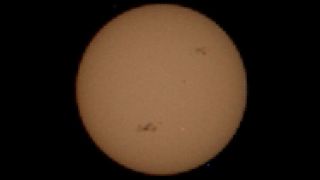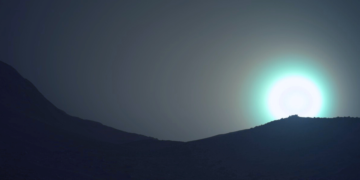The Sun’s wrath, recently unleashed upon Earth in the form of breathtaking auroras courtesy of the monstrous sunspot AR3664, has shifted its focus.

As Earth basks in the afterglow, Mars now steps into the spotlight, poised for a celestial spectacle of its own. The once Earth-facing sunspot has rotated out of view, but its energetic influence travels outward, and the Red Planet now finds itself in the direct path of the solar storm.
MAVEN: A Front-Row Seat to the Martian Lights
Occupying a prime observation post, NASA’s MAVEN spacecraft stands ready to witness the Martian light show firsthand. Equipped with the sophisticated Extreme Ultraviolet Monitor (EUVM), MAVEN has already detected the strongest solar flare observed since its Martian arrival in 2014.
This immense burst of energy is predicted to rapidly heat and ionize the upper reaches of the Martian atmosphere, potentially doubling its temperature for a few hours and causing a global inflation. The resulting atmospheric ballet will be meticulously documented by MAVEN, offering invaluable data for scientists.
Perseverance: Capturing the Celestial Spectacle
Not to be outdone in this celestial observation, NASA’s intrepid Perseverance rover also holds a coveted front-row seat. With an unobstructed view of both AR3664 and its predecessor, AR3663, Perseverance will experience the full brunt of the incoming coronal mass ejection (CME) – a surge of solar plasma and magnetic field. This interaction is anticipated to generate a global aurora that will paint the Martian sky in a dazzling display of colors. Perseverance’s unique position allows it to not only witness this breathtaking phenomenon but also potentially capture stunning imagery for further analysis.
A Glimpse into Mars’ Atmospheric Past
Unlike Earth, Mars lacks a robust magnetic shield, leaving it vulnerable to the onslaught of charged particles unleashed by the Sun. This very vulnerability presents a fascinating scientific opportunity. By closely monitoring the Martian atmosphere during this solar event, MAVEN scientists hope to gain crucial insights into how the early Sun, with its heightened activity, may have stripped Mars of its once-thick atmosphere, transforming it into the cold, arid world we know today. The data collected during this solar storm will serve as a missing puzzle piece in understanding the dramatic atmospheric evolution of Mars.
A Collaborative Effort to Unlock Martian Secrets
The combined observations from MAVEN and Perseverance represent a significant leap forward in our quest to unravel the mysteries of the Martian atmosphere. Studying the impact of the CME will not only provide valuable data on the current state of the Martian atmosphere but also shed light on the powerful processes that sculpted Mars’s past. This collaborative effort between spacecraft signifies a critical step in understanding the Red Planet’s atmospheric evolution and its potential for harboring life.
A Moment of Anticipation: Awaiting the Martian Light Show
With the CME hurtling towards Mars, the scientific community is abuzz with anticipation. The prospect of witnessing a spectacular auroral display on a global scale, unlike anything ever observed before, has ignited excitement. This event promises to be more than just a celestial spectacle; it’s a valuable scientific opportunity, offering a glimpse into the dynamic relationship between Mars and the Sun, potentially revealing secrets about the planet’s atmospheric history and its suitability for harboring life as we know it. As the solar storm unfolds, the world will be watching with bated breath, eager to witness the Martian light show and the scientific Erkenntnisse – German for “insights” or “findings” – it will bring.


















